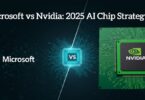When you hear $100 billion, you probably think of government budgets or mega-mergers. But now, that number is tied to artificial intelligence. According to reports from The Information and Bloomberg, OpenAI is planning a $100B supercomputer project — often referred to internally as “Stargate” — and Nvidia is expected to play a critical role as the chip supplier.
While neither company has officially confirmed the details, the scale of this rumored investment highlights one thing: the future of AI depends heavily on hardware. Let’s explore why this potential OpenAI–Nvidia collaboration matters and what it could mean for the global AI race.
Why AI Needs Massive Chip Power
Advanced AI models like ChatGPT, multimodal systems, and tools such as Google’s Veo 3 Could Change How We Make Videos Forever require staggering amounts of computing power.
- Training costs are skyrocketing: Training a large-scale AI model can take months and require tens of thousands of GPUs.
- Inference demand is growing: Every interaction with an AI assistant, video generator, or learning platform consumes compute resources.
- Bigger models ahead: OpenAI has hinted that future versions (like GPT-6 and beyond) will dwarf current models in size and complexity.
That’s why a $100B infrastructure plan isn’t as wild as it sounds — AI growth is already pushing the limits of existing supercomputers.
The $100B “Stargate” Plan
Reports suggest OpenAI is developing a supercomputer codenamed Stargate, with a projected cost of around $100 billion. Nvidia, the world’s leading supplier of AI GPUs, would likely provide much of the hardware.
What this project could involve:
- Custom AI supercomputers built at unprecedented scale.
- Next-generation Nvidia chips (like the Blackwell architecture).
- Data center expansions to rival those of Microsoft, Google, and Amazon.
If realized, this would represent one of the largest single investments in computing infrastructure in history.
Why Nvidia and OpenAI Make Sense as Partners
- For OpenAI: Securing a reliable chip supply is critical to keep advancing its models. A partnership with Nvidia could guarantee access to cutting-edge hardware.
- For Nvidia: Aligning with OpenAI cements its role as the dominant supplier in the AI chip market, keeping competitors at bay.
The rumored deal isn’t just about buying chips — it’s about building the backbone of the next era of artificial intelligence.
The Global AI Chip Race
The OpenAI–Nvidia partnership would also have huge implications for the global chip race:
- U.S. vs. China: Both nations are investing heavily in AI chip capacity.
- Other chipmakers: AMD, Intel, and startups like Cerebras are trying to cut into Nvidia’s dominance.
- Cloud giants: Google, Amazon, and Microsoft are building their own chips to reduce dependence on Nvidia.
Still, Nvidia remains years ahead in performance and developer adoption, thanks to its CUDA ecosystem. A massive deal with OpenAI would only widen that gap.
Real-World Impact of a $100B Supercomputer
So how does this trickle down to the average person? If the project moves forward, we could see:
- Smarter AI assistants with richer, faster responses.
- Breakthroughs in video AI, building on technologies like Google’s Veo 3 Could Change How We Make Videos Forever.
- Education at scale, enhanced by innovations like How Generative AI is Transforming Online Learning in 2025.
- Healthcare and biotech discoveries powered by faster model training.
In short, more chips mean more powerful and capable AI systems across every industry.
Challenges and Risks
Of course, a $100B project won’t be easy. Key challenges include:
- Supply chain strain: Chip manufacturing capacity is already stretched thin.
- Energy consumption: Training and running AI at this scale requires enormous amounts of electricity.
- Geopolitical pressures: Export restrictions and chip bans could complicate Nvidia’s ability to meet demand.
- ROI concerns: Can AI products generate enough revenue to justify such massive investment?
Curious how all this raw computing power translates into actual AI experiences? Don’t miss our guide on How Generative AI is Transforming Online Learning in 2025 — it’s a glimpse into how AI breakthroughs are already reshaping education.
The Road Ahead for OpenAI and Nvidia
If OpenAI’s Stargate project moves forward with Nvidia as its core partner, it could:
- Cement Nvidia’s role as the AI chip leader.
- Give OpenAI the infrastructure to pursue Artificial General Intelligence (AGI).
- Trigger even more aggressive investments from competitors.
- Accelerate the development of AI applications across sectors.
Whether the deal ends up being $100B or something smaller, the signal is clear: the AI future is being built on chips, and OpenAI wants a massive slice of that power.
The reported $100B OpenAI–Nvidia chip initiative may not be officially confirmed yet, but it reflects the scale of ambition driving today’s AI revolution. With compute as the limiting factor, hardware partnerships of this size could define the next decade of innovation.
For creators, businesses, and educators, the takeaway is simple: AI capabilities will keep expanding — and fast. The question is no longer if but how quickly we’ll see these changes filter into everyday tools.
Want to stay ahead of the AI race? Keep exploring our deep dives into Ai and tech, including Google’s Veo 3 Could Change How We Make Videos Forever and other AI innovations shaping tomorrow. And don’t forget to subscribe for the latest updates — because in AI, the future arrives faster than you think.






